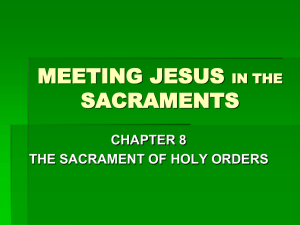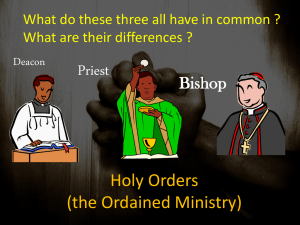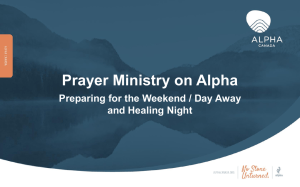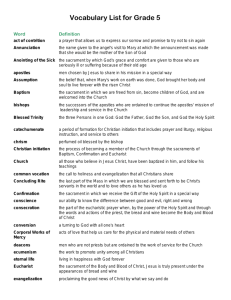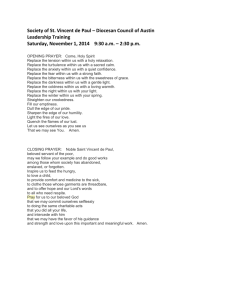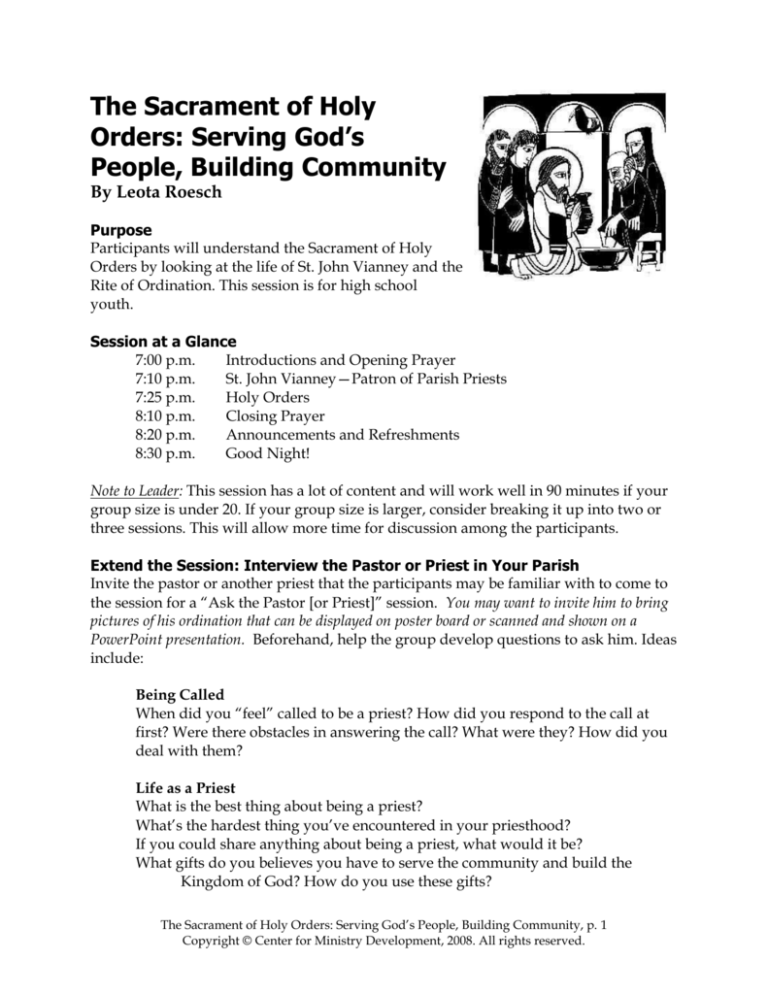
The Sacrament of Holy
Orders: Serving God’s
People, Building Community
By Leota Roesch
Purpose
Participants will understand the Sacrament of Holy
Orders by looking at the life of St. John Vianney and the
Rite of Ordination. This session is for high school
youth.
Session at a Glance
7:00 p.m.
Introductions and Opening Prayer
7:10 p.m.
St. John Vianney—Patron of Parish Priests
7:25 p.m.
Holy Orders
8:10 p.m.
Closing Prayer
8:20 p.m.
Announcements and Refreshments
8:30 p.m.
Good Night!
Note to Leader: This session has a lot of content and will work well in 90 minutes if your
group size is under 20. If your group size is larger, consider breaking it up into two or
three sessions. This will allow more time for discussion among the participants.
Extend the Session: Interview the Pastor or Priest in Your Parish
Invite the pastor or another priest that the participants may be familiar with to come to
the session for a “Ask the Pastor [or Priest]” session. You may want to invite him to bring
pictures of his ordination that can be displayed on poster board or scanned and shown on a
PowerPoint presentation. Beforehand, help the group develop questions to ask him. Ideas
include:
Being Called
When did you “feel” called to be a priest? How did you respond to the call at
first? Were there obstacles in answering the call? What were they? How did you
deal with them?
Life as a Priest
What is the best thing about being a priest?
What’s the hardest thing you’ve encountered in your priesthood?
If you could share anything about being a priest, what would it be?
What gifts do you believes you have to serve the community and build the
Kingdom of God? How do you use these gifts?
The Sacrament of Holy Orders: Serving God’s People, Building Community, p. 1
Copyright © Center for Ministry Development, 2008. All rights reserved.
How can we support you in your priesthood?
Option: Assign the participants in groups of two or three to interview their pastor and
other priests they know (using the above questions) and report back to the other
participants what they have heard and what it means for them.
Note to Leader: You may wish to extend the invitation for the end of the time together so
that participants can make reference to what they have already heard and learned as
they conduct “the interview.” If the participants have interviewed a priest in pairs, they
may also wish to share what they have learned at the end of the time together so that
the participants can evaluate what they are told by what they have experienced in the
session.
Materials Needed
• Newsprint and markers
• Nametags
• Materials for prayer setting
Small table covered with a nice cloth
Bible (use one that is of significant size and is not dirty or tattered)
Large candle
Cross or crucifix
• Handout 1, Opening Prayer, one for each participant
• Handout 2, Closing Prayer, one for each participant
• 3 x 5 index cards, or similar sized paper, for each participant
• Pen or pencil for each participant
Prepare in Advance
1. Set up the gathering space so it is conducive to dialogue and sharing:
Suggestion: The cluster style is good for presentations with breakout
groups. Clusters easily return to being a single group. Tables can be either
round or rectangles.
2. Set up tables for refreshments and sign-in. Have one or two people at the sign-in table
with a check-in sheet and name tags. Hospitality is important: As the facilitator, do not
use the gathering time before the session begins to take care of last minute preparations
Spend the time moving among the participants, greeting and speaking with them.
3. Prepare a prayer focus using the materials mentioned above.
4. Prepare a prayer leader/reader for the opening and closing prayers.
The Sacrament of Holy Orders: Serving God’s People, Building Community, p. 2
Copyright © Center for Ministry Development, 2008. All rights reserved.
5. Read and become familiar with the story of St. John Vianney so that you can recount
it with familiarity during the first part of the gathered session. The resource page
provides a variety of sources for your preparation.
Session Outline
Introduction and Prayer (10 minutes)
Greet the participants warmly as they arrive and give everyone a nametag. If there are
folks that are new, allow them to introduce themselves and receive a warm welcome to
the evening. Introduce tonight’s session in these or similar words:
All of us are called to serve others; in that sense, the Sacrament of Holy Orders
begins with Baptism, as do all the other sacraments. Holy Orders, along with the
Sacrament of Matrimony (Marriage), are called “Sacraments at the Service of
Communion and Mission.” Basically, this means that those men called to Holy
Orders are called in a unique way to serve the People of God and to build up the
Body of Christ. They are called to be servant leaders of their community.
For most of us, we understand Holy Orders as the sacrament by which one becomes
a priest. But Holy Orders is plural because it names three sacramental orders: the
Order of the Episcopate (bishops), the Order of Presbyters (priests), and the Order of
Deacons.
Let us now begin our time together in prayer.
Note to Leader: Invite the participants to gather around (or focus on) the prayer set-up.
Distribute Handout 1, Opening Prayer, and invite prayer leaders/readers forward. In
order that the breaking open of the Word from the reading from Philippians proceeds
smoothly, you may wish to lead this part rather than the youth prayer leaders.
St. John Vianney—Patron of Parish Priests: Model of Priesthood (15 minutes)
Invite participants to take several seconds to recall the word or phrase that struck them
during the opening prayer from Philippians. Then ask the group to share the words or
phrase that spoke to them of the qualities they would like to see in a priest. Write the
words/phrases on the board or on newsprint as the participants say them out loud in
the large group. Ask:
Have you ever wanted to do something so much but so many things come up that
what you want to do never happens? Or that everyone around you says it can’t be
done, or, if it can, you are not the one who can do it?
If there seems to be one or two participants who seem to want to share such a
story about their own lives, allow it, but keep the sharing relatively short.
I would like to share with you the story of a person, a priest, who overcame many
challenges to achieve his heart’s goal. His name is John Vianney… and he is the
patron of parish priests (and after whom many seminaries and houses of
discernment are named).
The Sacrament of Holy Orders: Serving God’s People, Building Community, p. 3
Copyright © Center for Ministry Development, 2008. All rights reserved.
Take time now to recount the story of St. John Vianney. Be sure to include the following
points:
1. John Vianney almost didn't become a priest at all.
a. His father didn’t want to lose his help on the family farm, and agreed
reluctantly to let him go to the seminary.
b. However, he was drafted into Napoleon's army, and was mistakenly
accused of deserting and had to hide for nearly two years.
c. When he was finally able to return to school at a late age, he did not do
well in his studies and failed the entrance exam for the seminary.
d. When he was finally accepted into the seminary, he failed the final exams
because he couldn't write well enough and became confused and tonguetied in the oral exams.
2. It took a special appeal to the Church of France to get permission to be
ordained. The vicar general of the diocese supposedly asked, “Is he pious?”
And the answer was that yes, he was very pious. “Ordain him,” the vicar
general decided, “The grace of God will do the rest.”
3. He was a simple, compassionate man, and humble.
4. His assignment to Ars as Curé (pastor).
5. Talk about his gift as a confessor and the large numbers of people who came
to celebrate the Sacrament of Confession with him.
6. Add those details of his life that illustrate the qualities that the participants
pointed out from their breaking open the readings from Philippians.
“It is remarkable that a poor village boy, who couldn’t pass his exams in the
seminary, later became a universal symbol of the Church’s clergy. John
Vianney reminds us that the true love of Christ can powerfully manifest itself
through guileless prayer and service.” (Greg Heffernan)
As you listened to the story of St. John Vianney, what impressed you most about his
life?
What qualities that you’ve named already as being important in the life of a priest
did you discover in John Vianney’s own story? How did he use his gifts in serving the
people of Ars and so many others?
Let us look more closely now at the Sacrament of Holy Orders, remembering the
model of priesthood that we have seen in St. John Vianney.
Holy Orders (45 minutes)
Step 1: (5 minutes) Sacraments in General
As Catholics, we have seven sacraments: baptism, confirmation, reconciliation,
Eucharist, holy orders, marriage, and anointing of the sick. All of the sacraments are
“human activities”—washing, anointing, absolving, eating and drinking, laying on of
hands, etc.—and they all become ways and means of encountering Christ—a
definition of a sacrament. An encounter with Christ is only possible because of the
gift of faith which comes to us in baptism—the initial sacrament of our faith.
The Sacrament of Holy Orders: Serving God’s People, Building Community, p. 4
Copyright © Center for Ministry Development, 2008. All rights reserved.
Another important thing about celebrating the sacraments is to remember that all
the sacraments are actions of the community—of us—of the entire Church—and are
never JUST for the individual being ordained, or baptized or confirmed, or absolved,
etc. Sacraments are necessary for the life of the community, the Church, and for
completing the mission of Christ.
Step 2: (15 minutes) Sacrament of Service – Holy Orders
Listen to this from the Ordination Rite for Priests:
“It is true that God has made his entire people a royal priesthood in
Christ. But our High Priest, Jesus Christ, also chose some of his
followers to carry out publicly in the Church the priestly ministry in
his name on behalf of mankind. He was sent by the Father, and he
in turn sent the apostles into the world; and through their
successor, the bishops, he continues his work as Teacher, Priest,
and Shepherd. Priests are co-workers of the order of bishops. They
are joined to the bishops in the priestly office and are called to
serve God's people.”
We see two things in this suggested homily by a bishop to someone who is about to
be ordained to the priesthood.
All of God’s people are a “royal priesthood” —we are all called to serve God’s
people. The fundamental “order” of the church is the order of all the faithful,
all of us who are baptized.
God calls some men to be especially public in their service of the People of
God. Those men who are to be ordained are to be leaders through service—just
as we hear Christ say in the Gospel of Matthew (20:28), “I come to serve and
not to be served.” We come to understand this statement of Christ’s even
better after he washes his apostles’ feet at the Last Supper which we read
about in John’s Gospel.
The Church teaches that ordination is directed towards the salvation of others and to
build up the people of God. In living their baptismal charism, deacons, priests, and
bishops serve the whole order— the community—of the faithful.
Ask the participants how they have experienced the leadership of service from priests
they have known. List their responses on a board or on newsprint. Comment on any
that might require further explanation or need to be emphasized.
Step 3: (25 minutes) The Meaning of Holy Orders
In the early church no one could be ordained who wasn’t “attached” to a community
—to a parish. The church today, following the teaching of Vatican Council II, teaches
that those men who are ordained know that their ministry is deeply bound to the
people they are called to serve. No one is ordained for the sake of his own personal
salvation or holiness.
The Sacrament of Holy Orders: Serving God’s People, Building Community, p. 5
Copyright © Center for Ministry Development, 2008. All rights reserved.
“The ministerial priesthood is at the service of the common
priesthood of the faithful. For when the priest celebrates the
Eucharist and administers the sacraments, he leads the faithful to
an awareness of their own particular sharing in the priesthood of
Christ.” Letter of His Holiness John Paul II to Priests For Holy
Thursday 1996
One important way to understand the meaning of the Sacrament of Holy Orders is to
look at the name of the sacrament itself— “Holy Orders”. A man who is ordained
enters an “order.” As early as the 3rd century, the church adapted this word from
the government in the Roman Empire and used and still uses it to refer to the groups
of people set aside for a particular ministry. Ordination isn’t about giving or getting
“power” but about entering an order of ministry, of service.
The Rite of Ordination for each of the particular orders gives us insight into the basic
meaning for each of the orders.
1. A new bishop is ordained by at least three other ordaining bishops. All the
ordained bishops present lay hands on the man to be ordained bishop.
2. Similarly, all the priests present at the ordination of a priest impose hands on
him after the bishop ordains him.
3. When a deacon is ordained, all the deacons present share the sign of peace
with the new deacon after his ordination by the bishop as a sign of their
welcoming him into their order.
In each of these rites, it is clear that these men are entering a group of others like
them who share the same ministry in the church. Holy Orders is not a sacrament
that is “received”; rather, in the sacrament, the ordained join a particular group of
people who are recognized by the Church as being called to serve in a particular
ministry. A new bishop is told, “Never forget that you are joined to the College of
Bishops.” Ordination isn’t about what it “permits” the ordained to “do”, but it is about
the place of the ordinand within the community of the faithful. Any power that is
exercised by ordained clergy flows from the role of that order in serving God’s
people. Servant leadership is for the community—not for the one exercising it.
Holy Orders in the church is a sacrament that provides a way of “ordering” the
community of the faithful. Holy Orders creates a relationship between the ordained
and us—the Church. All three Orders create a permanent relationship between these
men and the community—hence, like baptism and confirmation, Orders confers an
indelible mark/character on the person ordained.
Remember that we said sacraments are encounters with Christ, so the ministers in
each of the Orders also serve as sacraments because they make Christ visible to us
through and in their ministries, and they also “proclaim the nature of the church.”
(Lawrence Mick)
If all of us are called by Baptism to be servants of others, then some of us
should be ordained as deacons to be reminders or “icons” of the Servant who
is Christ among us.
If all of us are called to holiness by virtue of our Baptism, then some of us
should be ordained as priests to be living witnesses of that holiness through
their dedication to the sacramental ministry, especially the Eucharist.
The Sacrament of Holy Orders: Serving God’s People, Building Community, p. 6
Copyright © Center for Ministry Development, 2008. All rights reserved.
If all of us are called by Baptism to be leaders in the global community, then
some of us should be ordained as bishops to be witnesses and icons of Christ
who is King.
The Sacrament of Holy Orders creates three Orders of the ordained who lead the
community by being living symbols of service in our midst. They remind us all of our
responsibility to fulfill the mission of Christ through the building up of the community
through service; to be, as someone has said, “to be the hands and feet of Christ in
the (21st) century.”
Have any of you ever been to an ordination of a bishop, a priest, or a deacon? What
do you remember most about the celebration? Did you hear or see anything in the
celebration of the sacrament that gave you an insight into the ministry of the man
who was ordained? What was that?
Allow time for some sharing to take place.
Let us take a look now at each of the orders in turn.
Bishop
The Greek word that we translate as “bishop” is episkopos which means “overseer”
—supervisor. A bishop is ordained to guide the work of the church, to govern the
community, to coordinate the ministries of the Body of Christ. The ordination rite for
a bishop asks that God pour out the Spirit of governance on him. He is to shepherd
the flock that God gives to him and he is also to assign ministries among the
community. As we said before, he also becomes part of the world-wide College of
Bishops, sharing with them the care of the universal church.
a. A bishop’s crozier (a shepherd’s staff) is a symbol of his role as pastor
of his flock.
b. His mitre (the pointed hat) is another symbol of his ministry. The
bishop is the chief teacher/catechist of his diocese, and the mitre is a
symbol of his teaching authority.
If the bishop symbolizes for us unity in the church and if his leadership is a symbol
for us of how we are to lead, how can we lead in the church as “servant” instead of
as someone concerned only with power?
Encourage discussion in the large or small groups on how young people can be servant
leaders in their communities as the bishop models for all of us. Encourage discussion,
also around the role of being a promoter of unity—how can young people work for
unity in family and school?
Priest – Order of Presbyter
This Greek word means “elder” but does not accurately tell us of the role of the
priest. The rite of ordination emphasizes the priest’s role as a co-worker with the
bishop—as we hear in the Rite of Ordination:
“May they be worthy co-workers with our Order, so that by their
preaching and through the grace of the Holy Spirit, the words of the
Gospel may bear fruit in human hearts and reach even to the ends
of the earth. Together with us, may they be faithful stewards of
your mysteries, so that your people may be renewed in the waters
The Sacrament of Holy Orders: Serving God’s People, Building Community, p. 7
Copyright © Center for Ministry Development, 2008. All rights reserved.
of rebirth and nourished from your altar; so that sinners may be
reconciled and the sick raised up.” (Rite no. 131)
After the new priest is vested, he kneels before the bishop at the Presentation of
the Gifts and receives from him the gifts that have been brought forward by the
community. The bishop says, “Accept from the holy people of God the gifts to be
offered to him. Know what you are doing, and imitate the mystery you celebrate:
model your life on the mystery of the Lord's cross.”
What do you think those words of the bishop to the new priest mean? What do
those words say about us? Do you know examples of priests who have lived as the
bishop asked them to do at their ordination? Can you share a story about how a
priest you know models his life “on the mystery of the Lord’s cross”?
Allow time for some sharing to take place.
In the very early church, the presbyters performed the same function of the bishop
when the bishop could not be present, so, today, in a different way, the priest
symbolizes the same ministerial aspects that the bishop does but in his own small
community. He presides at (celebrates) Mass (liturgy) and sacraments, preaches the
Word of God, and fosters the growth of the community by calling and enabling his
people for ministry and service—just like the bishop does for the whole diocese.
How can we assist our pastor in our own parish in his role? If he symbolizes our
role in the “royal priesthood” of the faithful, how are we “priest” in our parishes?
How do we serve? proclaim the Word?
Note to Leader: This is a huge discussion, since it gets at the heart of the relationship
between the ordained and the laity. How do the two relate to each other and help each
other to grow and to keep each other authentic in the way of discipleship? This is a
discussion that could easily last over an hour.
Deacon
Diakonia in Greek means service—and that is the primary role of the deacon. We
read in Acts 6:1-5 that there was so much need in the community of the early
church that the apostles couldn’t find time to preach the Word and evangelize in the
name of the Trinity as Christ had commissioned them. So they made a communal
decision to call the first seven deacons of the church to serve the poor, the hungry,
the widow, the orphan, the stranger. First and foremost, the role, the ministry of the
deacon is to serve those who are in need. Their service at the altar is a corollary to
this role. They witness daily to us that it is an essential part of Christ’s mission to
care for the grieving, the dying, the lonely, the hungry, the oppressed, the homeless
—all those who are at the margins of our society.
“May there abound in them every Gospel virtue, unfeigned love,
concern for the sick and poor, unassuming authority, the purity of
innocence, and the observance of spiritual discipline … so that by
imitating on earth your Son, who came not be served but to serve,
they may be found worthy to reign in heaven with him. Who lives
and reigns with you.” (Rite no. 207)
The Sacrament of Holy Orders: Serving God’s People, Building Community, p. 8
Copyright © Center for Ministry Development, 2008. All rights reserved.
The deacon also has a liturgical role at the celebration of the Eucharist which is
linked to his ministry of charity. Besides proclaiming the Word, offering our
intercessions, and distributing the cup (Blood of Christ), it is the deacon’s role to
receive the gifts of the people when they are presented—our offerings are to be
shared with the poor and the deacon’s role is to see that that happens.
How can or how do you/we share in the deacon’s role in our parish as servant
leaders whose special care is for the poor?
Conclusion and Prayer (10 minutes)
Tonight we have learned more about the Sacrament of Holy Orders and the role and
ministry of bishops, priests, and deacons in our church. We have learned that while
we all share in the priesthood of Christ, these ordained men are set apart especially
to serve the community, form the community, and unify the community. Their very
lives and ministry urge us to follow faithfully our own vocation to holiness. As they
are called to imitate Christ, so, too, are we. Their ministry in our midst exists to help
us do just that.
A final question that we will discuss is this: How can we support not only the work
and ministry of our bishop, priests, deacons, but also, how can we support them in
that ministry? I am going to give you a few minutes in which to think in silence on
how YOU are going to support them.
Allow a few minutes of silence, and then distribute the pencils/pens and paper on
which participants can write their commitment to take home with them. Invite the
participants to turn to the person next to them to share, if they feel comfortable, the
commitment they wrote on the index card. After a few minutes of sharing, distribute
Handout 2, Closing Prayer.
Announcements and Refreshments (10 minutes)
Make any necessary announcements, and invite the participants to enjoy some
refreshments.
The websites mentioned in this session were successfully accessed on February 15, 2008.
This session was written by Leota Roesch, Coordinator of Catechist Formation &
Children’s Catechesis, Department of Family Catechesis, Diocese of Phoenix.
The Sacrament of Holy Orders: Serving God’s People, Building Community, p. 9
Copyright © Center for Ministry Development, 2008. All rights reserved.
Handout 1
OPENING PRAYER
Call to Prayer
Prayer Leader: Let us take a moment to center ourselves on God
present within and among us. (Pause for about 30 seconds.) God
gives us breath and with each breath we breathe in the Spirit of
Peace and breathe out the concerns of our lives. (Invite participants
to take several deep cleansing breaths.)
Let us begin with the sign of our faith. In the name of the Father …
Overwhelm us with your Spirit, O God, so that the words we hear
will speak to our hearts. (Pause for about 30 seconds.)
Gather
Prayer Leader:
Good and gracious God, continue to raise up in your Church men who are strong in
their faith, compassion, and vision who will serve your people with love and lead
them with justice. Give our deacons, priests, and bishops wisdom to be prophetic,
joy in the proclamation of your Word, and reverence for your sacraments. We make
our prayer through Jesus, our Lord and Brother, who lives and reigns with you and
the Holy Spirit now and forever. Amen.
Listen
Prayer Leader:
Please listen for a word or phrase or thought in the Scripture reading that you
think describes the gifts that you would want to see in our pastor or another
priest you know. You will be invited to share that word or phrase after the
reading.
The reader proclaims Philippians 2:1-11.
Respond
Prayer Leader:
I invite each of us to share just the word or phrase that struck us in the
reading. I will share first, and then I will invite one person to share. After that
person offers his/her thought, word, or phrase, they will then invite someone
else to share.
Go Forth
Let us now continue our time together in peace. Amen.
The Sacrament of Holy Orders: Serving God’s People, Building Community, p. 10
Copyright © Center for Ministry Development, 2008. All rights reserved.
Handout 2
CLOSING PRAYER
Gather
Prayer Leader:
Hear us, Lord our God, you have poured out on your bishops, priests and deacons
the blessings of the Holy Spirit in their ordinations. We ask you to continue:
supporting them with your unfailing love. We ask this through Christ our Lord. Amen.
Listen
The reader proclaims John 20: 19-23. A few moments of silence follow the reading.
Respond
Litany of the Saints
Prayer Leader
Holy Mary:
Saint Michael and all angels:
Joseph, spouse of Mary:
Saint John the Baptist:
Saints Peter and Paul:
Saints Matthew and Mark:
Saints Luke and John:
Saint Mary Magdalene:
Saint Philip Neri:
Saint John Vianney:
All holy men and women:
Lord, be merciful:
From all evil:
From every sin:
From everlasting death:
By your Incarnation:
By your death and resurrection:
By your gift of the Spirit:
Guide your holy Church:
Keep the Pope and clergy faithful:
Bring all people together:
Strengthen us in service:
Bless these chosen men:
Make them holy:
Bless them in their service:
All
Pray for us.
Pray for us.
Pray for us.
Pray for us.
Pray for us.
Pray for us.
Pray for us.
Pray for us.
Pray for us.
Pray for us.
Pray for us.
Save your people.
Save your people.
Save your people.
Save your people.
Save your people.
Save your people.
Save your people.
Hear our prayer.
Hear our prayer.
Hear our prayer.
Hear our prayer.
Hear our prayer.
Hear our prayer.
Hear our prayer.
The Sacrament of Holy Orders: Serving God’s People, Building Community, p. 11
Copyright © Center for Ministry Development, 2008. All rights reserved.
Go Forth
Prayer Leader:
Father of mercy,
you made St. John Vianney outstanding
in his priestly zeal and concern for your people.
By his example and prayers,
enable us to win our brothers and sisters
to the love of Christ
and come with them to eternal glory.
We ask this through our Lord Jesus Christ, your Son,
who lives and reigns with you and the Holy Spirit,
one God, for ever and ever. (Taken from the old Roman
All:
Missal)
Amen.
The Sacrament of Holy Orders: Serving God’s People, Building Community, p. 12
Copyright © Center for Ministry Development, 2008. All rights reserved.
Resource 1
References/Resources for Facilitators
• The Jesuits of the New Orleans Province have a website with pictures and a
simple description of priestly ordination. Visit
http://norprov.org/news/ordinations2005.htm.
Note to Leader: Even though the pictures do not precisely match with the
presentation of the session, consider using this as a brief slide show with the
participants, many of whom have never been to an ordination.
Catechism of the Catholic Church [CCC] on Holy Orders: #’s 1534, 1537-1553; 15621568; 1581-1589, as well as:
o 875 “How are they to believe in Him of whom they have never heard?
And how are they to hear without a preacher? And how can men preach
unless they are sent?” No one -- no individual and no community -- can
proclaim the Gospel to himself: …. This fact presupposes ministers of
grace, authorized and empowered by Christ. From Him, bishops and
priests receive the mission and faculty (“the sacred power”) to act in
persona Christi Capitis; deacons receive the strength to serve the people of
God in the diaconia of the liturgy, word and charity, in communion with
the bishop and his presbyterate. The ministry in which Christ’s emissaries
do and give by God’s grace what they cannot do and give by their own
powers, is called a “sacrament” by the Church’s tradition. Indeed, the
ministry of the Church is conferred by a special sacrament.
o 1141 The celebrating assembly is the community of the baptized who, “by
regeneration and the anointing of the Holy Spirit, are consecrated to be a
spiritual house and a holy priesthood, that through all the works of
Christian men they may offer spiritual sacrifices.” This “common
priesthood” is that of Christ the sole priest, in which all His members
participate.
o 1142 But “the members do not every have the same function.” Certain
members are called by God, in and through the Church, to a special
service of the community. These servants are chosen and consecrated by
the sacrament of Holy Orders, by which the Holy Spirit enables them to
act in the person of Christ the head, for the service of all the members of
the Church. The ordained minister is, as it were, an “icon” of Christ the
priest. Since it is in the Eucharist that the sacrament of the Church is made
fully visible, it is in his presiding at the Eucharist that the bishop’s
ministry is most evident, as well as, in communion with him, the ministry
of priests and deacons.
The Sacrament of Holy Orders: Serving God’s People, Building Community, p. 13
Copyright © Center for Ministry Development, 2008. All rights reserved.
o
o
1375 It is by the conversion of the bread and wine into Christ’s Body and
Blood that Christ becomes present in this sacrament. The Church Fathers
strongly affirmed the faith of the Church in the efficacy of the Word of
Christ and of the action of the Holy Spirit to bring about this conversion…
1337 The Lord, having loved those who were His own, loved them to the
end. Knowing that the hour had come to leave this world and return to
the Father, in the course of a meal He washed their feet and gave them the
commandment of love. In order to leave them a pledge of this love, in
order never to depart from His own and to make them sharers in His
Passover, He instituted the Eucharist as the memorial of His death and
Resurrection, and commanded His apostles to celebrate it until His return;
“thereby He constituted them priests of the New Testament.”
Understanding the Sacraments: Holy Orders by Lawrence E. Mick. [Chicago:
Liturgical Press, 2007.]
John Vianney: The Saint Who Read Souls at a Glance by Greg Heffernan
http://www.americancatholic.org/Messenger/Mar2003/Feature3.asp#F2
Books on St. John Vianney – all available on Amazon.com
o The Cure D’Ars: Portrait of a Parish Priest by Lancelot Capel Sheppard, 1958.
o The Cure D’Ars Today: St. John Vianney by George William Rutler, 1988.
o The Remarkable Cure of Ars: The Life and Achievement of St. John Mary
Vianney by Michel de Saint Pierre, 1963.
The Sacrament of Holy Orders: Serving God’s People, Building Community, p. 14
Copyright © Center for Ministry Development, 2008. All rights reserved.

